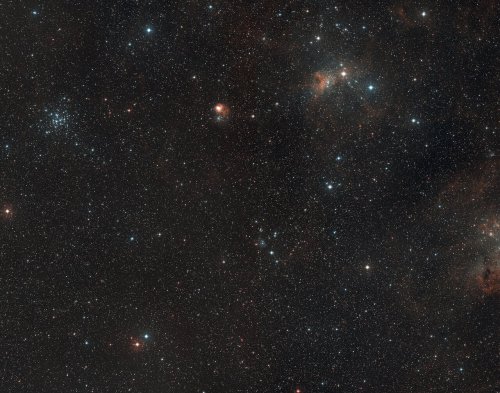
One of the essential elements for the development of life on Earth is phosphorus, which is a key structural element of DNA. However, there’s a puzzle about the origins of life on our planet: Scientists aren’t sure how phosphorus made its way here. It is an extremely reactive element, so it isn’t found naturally as a free element anywhere on Earth. Now, astronomers from the European Southern Observatory have traced the path of phosphorus from its interstellar origin, onto comets, from where it could be transported to our planet and form a building block for life.
Using the Atacama Large Millimeter/Submillimeter Array (ALMA), astronomers looked to the star-forming region AFGL 5142, shown above. Here, phosphorus-bearing molecules of phosphorus monoxide form when massive stars are born. As the young stars develop, they cause flows and cavities in the gas surrounding them, and the phosphorus molecules form on these cavity walls.
Sometimes, these cavities will collapse to form more new stars. And when a star forms, the phosphorus monoxide can freeze and become trapped in ice grains which orbit around it. Eventually, these grains can coalesce to form comets, which then carry the phosphorus molecules out into the galaxy and onto planets like Earth.
The scientists an instrument called ROSINA (Rosetta Orbiter Spectrometer for Ion and Neutral Analysis) on the Rosetta space probe to study the comet 67P/Churyumov–Gerasimenko and confirm it carried phosphorus monoxide.
“The combination of the ALMA and ROSINA data has revealed a sort of chemical thread during the whole process of star formation, in which phosphorus monoxide plays the dominant role,” Víctor Rivilla, the lead author the study and a researcher at Italy’s National Institute for Astrophysics, said in a statement.
This finding gives supporting evidence to the importance of comets in the development of life on our planet. “Phosphorus is essential for life as we know it,” Kathrin Altwegg, the principal investigator for Rosina, said in the statement. “As comets most probably delivered large amounts of organic compounds to the Earth, the phosphorus monoxide found in comet 67P may strengthen the link between comets and life on Earth.”
The findings are published in the journal Monthly Notices of the Royal Astronomical Society.
Editors' Recommendations
- Could the earliest building blocks of life have come from space?
- Astronomers spot a vast, mysterious circle in space
- Astronomers discover enormous planet in extreme, massive star system
- Astronomers want to build an epic $11B space telescope to replace Hubble
- Blue Origin wants to build a space station for ‘exotic hospitality’